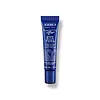What's inside
What's inside
 Key Ingredients
Key Ingredients

 Benefits
Benefits

 Concerns
Concerns

 Ingredients Side-by-side
Ingredients Side-by-side

Water
Skin ConditioningGlycerin
HumectantMyristyl Myristate
EmollientButylene Glycol
HumectantCaprylic/Capric Triglyceride
MaskingRicinus Communis Seed Oil
MaskingCetearyl Alcohol
EmollientCorn Starch Modified
AbsorbentCetearyl Isononanoate
EmollientCarthamus Tinctorius Seed Oil
MaskingCeteareth-20
CleansingGlyceryl Stearate
EmollientPEG-100 Stearate
Avena Sativa Kernel Extract
AbrasiveAloe Barbadensis Leaf Juice Powder
Skin ConditioningPisum Sativum Extract
Skin ConditioningBambusa Vulgaris Leaf/Stem Extract
HumectantOenothera Biennis Oil
EmollientCamellia Sinensis Leaf Extract
AntimicrobialHelianthus Annuus Seed Oil
EmollientLinum Usitatissimum Seed Oil
PerfumingPunica Granatum Seed Oil
EmollientHelianthus Annuus Seed Extract
Skin ConditioningCaffeine
Skin ConditioningPalmitoyl Tripeptide-38
Skin ConditioningTocopheryl Acetate
AntioxidantAscorbyl Palmitate
AntioxidantSodium Hyaluronate
HumectantSodium PCA
HumectantHydrogenated Coco-Glycerides
EmollientDimethicone
EmollientCaprylyl Glycol
EmollientTetrasodium EDTA
Ethylhexylglycerin
Skin ConditioningEDTA
Aminomethyl Propanol
BufferingCarbomer
Emulsion StabilisingOctyldodecanol
EmollientGlucosamine Hcl
Hydroxypropyl Cyclodextrin
MaskingPhenoxyethanol
PreservativeCyclopentasiloxane
EmollientWater, Glycerin, Myristyl Myristate, Butylene Glycol, Caprylic/Capric Triglyceride, Ricinus Communis Seed Oil, Cetearyl Alcohol, Corn Starch Modified, Cetearyl Isononanoate, Carthamus Tinctorius Seed Oil, Ceteareth-20, Glyceryl Stearate, PEG-100 Stearate, Avena Sativa Kernel Extract, Aloe Barbadensis Leaf Juice Powder, Pisum Sativum Extract, Bambusa Vulgaris Leaf/Stem Extract, Oenothera Biennis Oil, Camellia Sinensis Leaf Extract, Helianthus Annuus Seed Oil, Linum Usitatissimum Seed Oil, Punica Granatum Seed Oil, Helianthus Annuus Seed Extract, Caffeine, Palmitoyl Tripeptide-38, Tocopheryl Acetate, Ascorbyl Palmitate, Sodium Hyaluronate, Sodium PCA, Hydrogenated Coco-Glycerides, Dimethicone, Caprylyl Glycol, Tetrasodium EDTA, Ethylhexylglycerin, EDTA, Aminomethyl Propanol, Carbomer, Octyldodecanol, Glucosamine Hcl, Hydroxypropyl Cyclodextrin, Phenoxyethanol, Cyclopentasiloxane
Water
Skin ConditioningDimethicone
EmollientGlycerin
HumectantNiacinamide
SmoothingMethyl Methacrylate Crosspolymer
Caffeine
Skin ConditioningEthylhexyl Palmitate
EmollientDimethicone/Vinyl Dimethicone Crosspolymer
Skin ConditioningDimethicone/PEG-10/15 Crosspolymer
PEG-10 Dimethicone
Skin ConditioningHydroxyethylpiperazine Ethane Sulfonic Acid
BufferingSodium Chloride
MaskingPerlite
AbsorbentPhenoxyethanol
PreservativeChlorphenesin
AntimicrobialSodium Citrate
BufferingP-Anisic Acid
MaskingTocopherol
AntioxidantDisodium EDTA
Ascorbyl Glucoside
AntioxidantAdenosine
Skin ConditioningGlycine Soja Protein
EmulsifyingDipropylene Glycol
HumectantCaprylyl Glycol
EmollientSodium Cocoyl Glutamate
CleansingChlorhexidine Digluconate
AntimicrobialN-Hydroxysuccinimide
Skin ConditioningPotassium Sorbate
PreservativeEthylhexylglycerin
Skin ConditioningSodium Benzoate
MaskingPalmitoyl Oligopeptide
CleansingChrysin
Skin ConditioningPalmitoyl Tetrapeptide-7
Skin ConditioningWater, Dimethicone, Glycerin, Niacinamide, Methyl Methacrylate Crosspolymer, Caffeine, Ethylhexyl Palmitate, Dimethicone/Vinyl Dimethicone Crosspolymer, Dimethicone/PEG-10/15 Crosspolymer, PEG-10 Dimethicone, Hydroxyethylpiperazine Ethane Sulfonic Acid, Sodium Chloride, Perlite, Phenoxyethanol, Chlorphenesin, Sodium Citrate, P-Anisic Acid, Tocopherol, Disodium EDTA, Ascorbyl Glucoside, Adenosine, Glycine Soja Protein, Dipropylene Glycol, Caprylyl Glycol, Sodium Cocoyl Glutamate, Chlorhexidine Digluconate, N-Hydroxysuccinimide, Potassium Sorbate, Ethylhexylglycerin, Sodium Benzoate, Palmitoyl Oligopeptide, Chrysin, Palmitoyl Tetrapeptide-7
Ingredients Explained
These ingredients are found in both products.
Ingredients higher up in an ingredient list are typically present in a larger amount.
Caffeine is most associated with coffee, tea, and cacao. In skincare, it helps with calming inflammation and is rich in antioxidants.
While caffeine is used to treat cellulite and and dark circles, further studies are needed to prove this. It has been believed to help with these skin conditions due to its ability to dilate blood vessels and increase blood flow.
Some studies are looking into caffeine's ability to protect against UV rays.
Learn more about CaffeineCaprylyl Glycol is a humectant and emollient, meaning it attracts and preserves moisture.
It is a common ingredient in many products, especially those designed to hydrate skin. The primary benefits are retaining moisture, skin softening, and promoting a healthy skin barrier.
Though Caprylyl Glycol is an alcohol derived from fatty acids, it is not the kind that can dry out skin.
This ingredient is also used as a preservative to extend the life of products. It has slight antimicrobial properties.
Learn more about Caprylyl GlycolDimethicone is a type of synthetic silicone created from natural materials such as quartz.
What it does:
Dimethicone comes in different viscosities:
Depending on the viscosity, dimethicone has different properties.
Ingredients lists don't always show which type is used, so we recommend reaching out to the brand if you have questions about the viscosity.
This ingredient is unlikely to cause irritation because it does not get absorbed into skin. However, people with silicone allergies should be careful about using this ingredient.
Note: Dimethicone may contribute to pilling. This is because it is not oil or water soluble, so pilling may occur when layered with products. When mixed with heavy oils in a formula, the outcome is also quite greasy.
Learn more about DimethiconeEthylhexylglycerin (we can't pronounce this either) is commonly used as a preservative and skin softener. It is derived from glyceryl.
You might see Ethylhexylglycerin often paired with other preservatives such as phenoxyethanol. Ethylhexylglycerin has been found to increase the effectiveness of these other preservatives.
Glycerin is already naturally found in your skin. It helps moisturize and protect your skin.
A study from 2016 found glycerin to be more effective as a humectant than AHAs and hyaluronic acid.
As a humectant, it helps the skin stay hydrated by pulling moisture to your skin. The low molecular weight of glycerin allows it to pull moisture into the deeper layers of your skin.
Hydrated skin improves your skin barrier; Your skin barrier helps protect against irritants and bacteria.
Glycerin has also been found to have antimicrobial and antiviral properties. Due to these properties, glycerin is often used in wound and burn treatments.
In cosmetics, glycerin is usually derived from plants such as soybean or palm. However, it can also be sourced from animals, such as tallow or animal fat.
This ingredient is organic, colorless, odorless, and non-toxic.
Glycerin is the name for this ingredient in American English. British English uses Glycerol/Glycerine.
Learn more about GlycerinPhenoxyethanol is a preservative that has germicide, antimicrobial, and aromatic properties. Studies show that phenoxyethanol can prevent microbial growth. By itself, it has a scent that is similar to that of a rose.
It's often used in formulations along with Caprylyl Glycol to preserve the shelf life of products.
Water. It's the most common cosmetic ingredient of all. You'll usually see it at the top of ingredient lists, meaning that it makes up the largest part of the product.
So why is it so popular? Water most often acts as a solvent - this means that it helps dissolve other ingredients into the formulation.
You'll also recognize water as that liquid we all need to stay alive. If you see this, drink a glass of water. Stay hydrated!
Learn more about Water